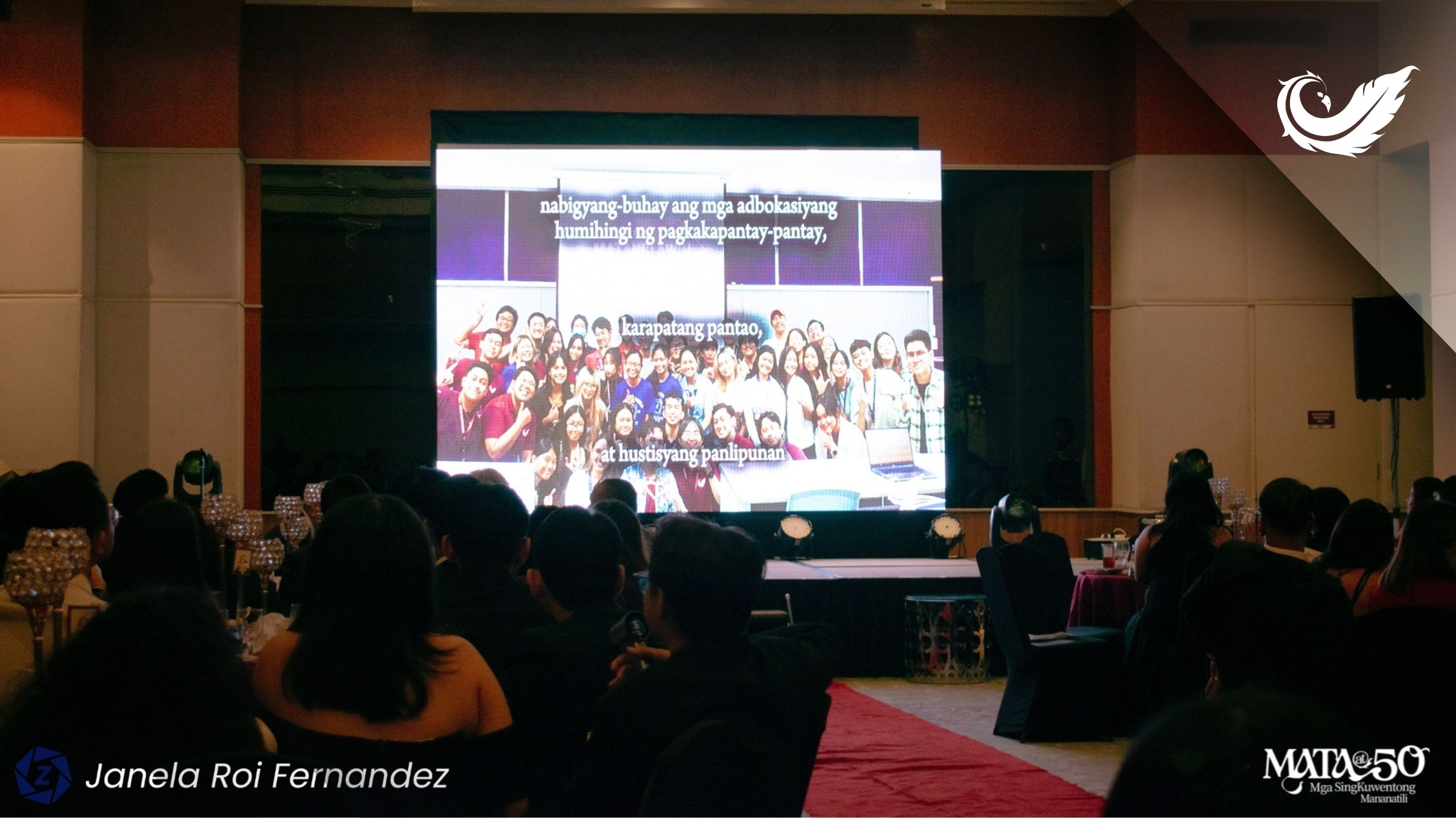
Not surprisingly, details are sketchy on how Matanglawin, the Ateneo’s official publication in Filipino, began in 1975. Matanglawin’s website offers a brief accounting:
Taong 1975, nagsimula ang Matanglawin bilang isang mosquito press noong panahon ng batas militar ni Marcos. Sinisingit ang isa hanggang dalawang pahinang isyu ng Matanglawin sa mga libro sa silid-aklatan at dito tagóng ipinapakalat ang mga balitang kumikilatis sa mga karumal-dumal na pangyayaring umiiral sa lipunan.
This is a reconstruction at best. It’s quite incomplete. To set the socio-cultural context: In 1975, the Ateneo was in the midst of a progressive move toward Filipinization. The curriculum, extra-curricular activities, even the medium of classroom instruction sought ways to explore greater use of Filipino as a professional language – for academic, technical, social, and even scientific applications.
In 1975, I was majoring in Filipino, one of only two in the relatively new Kagawaran ng Pilipino. Outside the Ateneo, the magazine Sagisag began publishing early that same year. Strangely enough, it was published by a small nerdy office within the Marcos administration’s Department of Public Information.
It was a groundbreaking magazine that used Filipino exclusively—not just for literary writing—but for professional and intellectual discourse. The look of the magazine—glossy, full-color, heavy paper stock—echoed the message that modern Filipino can, and should be used, at the highest possible levels.
In all candor, Sagisag Magazine was my model. I also was emboldened by the Filipinization movement sweeping the campus and by personal ties to my field of study. Lastly, I was inspired by the writings of my grandfather, Juan L. Arsciwals, a novelist, playwright and Taliba socio-political columnist during the American period.
And thus grew the idea of an underground newsletter in modern Filipino. My motive was to disrupt—and maybe, at times, offend—a ‘burgis’ Atenista culture where most people affected a kind of ‘konyo’ English. (Has the environment changed much in 2025?)
“Grabe, like, I was so pagod na, you know?”
“How baboy naman the pig.”
I started preparing the first issue of Matanglawin sometime in the third quarter of 1975. I borrowed the name from one of the characters of Aurelio Tolentino’s Kahapon, Ngayon at Bukas (1903) for no stronger reason than I liked the name. I knew what the character “matanglawin” symbolized in the play (the Spanish government) and I also knew that “lawin” or hawk did not evoke the Ateneo mascot. But artistic license held stronger sway and trumped actual meaning.
It’s been surmised that a collective founded Matanglawin. This is not factual. I started the publication alone. The first issue was a 2-page pamphlet. I wrote all the pieces inside and even produced the amateurly drawn baybayin masthead.
As far as I can remember, I deliberately did not label the first issue as issue number 1. What the Rizal Library has in its archives as “Blg. 2, Tomo I” is actually the maiden issue. I wanted to obscure the origins of the publication. I wanted to confuse people into thinking that a first issue had already circulated. This also was why I kept the author or publisher anonymous. We were under Martial Law after all. And I did not exactly ask permission from the Ateneo university administration to publish and circulate the pamphlet.
I produced the first few issues at home. I used an old, manual Underwood typewriter passed on to me by my mother, Luzviminda (who wrote for Liwayway and Aliwan magazines, and sometimes for television). You may ask how I managed to have justified columns? I literally counted the number of characters per line and added spaces or hyphenations when necessary. I typed the columns on clean bond paper, then cut and pasted them onto another—desktop publishing at its crudest.
I had no drawing skills whatsoever. For graphics, I brazenly stole from existing magazines of the time. For one issue, my sister Madonna Davidoff (now a professional graphics artist and book designer in New Jersey, USA) did some drawings gratis et amore. After finishing the camera-ready pages, I photocopied them at a small shop (now long gone) just across Gate 3 of the Ateneo campus. I paid for everything with my pocket money.
A few people did know I was behind Matanglawin, though. One in particular was a good friend, philo teacher Eduardo Jose ‘Ediboy’ Calasanz, who is today Superior General of the Sons of Notre-Dame de Vie in France. I like to believe that faculty members of the Kagawaran ng Pilipino suspected I was behind it. If they did, they never shared their suspicions to anyone. Over time, I told Fr. Bienvenido S. Nebres, then Dean, College of Arts and Sciences, that I was responsible for Matanglawin. He offered no objections and even quietly helped to pay for later issues, which were printed in tabloid format. Dr. Antonette Palma-Angeles, my wife whom I met in late 1975, also knew I was the person behind the publication.
Within a few months, Matanglawin did become a kind of collective. A handful of like-minded friends either helped me produce the printed editions or offered support and encouragement. I recall the names of Eduardo Cadiz, Jr., Ricardo Saludo and Jeremias Jimenez. They and several others helped to circulate copies surreptitiously by leaving them at the Rizal Library, in classrooms, the cafeteria, and during basketball games at the Blue Eagle Gym.
On occasion, we would sit down as a clique in classrooms where the lecturer taught in English. We annoyed the teacher immensely by speaking only in Filipino during discussions. (This was not a good way to endear ourselves to our classmates.) I remember one class in particular with an American teacher whose name I forget. We asked if we could answer our quiz papers and exams only in Filipino. He was young and quite earnest. That thoroughly flustered him. Embarrassed, he muttered that he wouldn’t know how to grade our papers if we didn’t write in English. It was a lot of fun!
Did we actually offend anyone? I remember at least one instance when we did: A theology professor became upset with one of our editorial cartoons. He thought it was meant to portray him—which in fact it was. Fortunately (and unlike a certain ex-official of the Overseas Workers Welfare Administration) he eventually took the drawing in the spirit with which it was published, as social commentary absent of malice. He became a lifelong friend to me and my wife.
As to Matanglawin’s overriding purpose, my editorial in issue number 3, “Aming matwid”, explains the rationale clearly: “Layunin ng MATANGLAWIN na palaganapin ang mainam na Pilipino sa Pamantasan.” My intention was to help grow and mainstream the language, in the same way that German or Japanese have always been mainstreamed not only in the arts but in science, industry, mathematics, sociology, government, instruction, and socio-political discourse.
Even though the primary aim was not political, the pieces I wrote for Matanglawin dwelt, by default, on progressive, nationalist and socially-aware themes. After all, I and the publication were very much spawns of the prevailing milieu. I was on the fringes at that time of a few political organizations both in and outside the Ateneo and was among the first batch of Ateneans who underwent 2-month immersions in rural villages.
This brings me to another point about the manner of writing. The early issues of Matanglawin consciously sought to evoke the flavor of some writers of the Propaganda Movement in the Philippines during the late 19th century. One such writer was Marcelo H. Del Pilar, whose satirical essay “Caiingat cayo” became a kind of loose template for the early editions. I even borrowed the title for the maiden issue’s essay.
Let me add that syntax, grammar, vocabulary and general language usage in the early editions owed much to Filipino sa Pamantasan, a slim pamphlet of writing guidelines developed by the late Rolando S. Tinio, who was then teaching at the Ateneo. I credit Mr Tinio’s influence with grounding Matanglawin on Filipino written within an academic and professional setting. I also attended a class he gave on how to do modern Filipino translations of English text. It gave Matanglawin a strong foundation on standards and methods of adapting Filipino for use in the modern professions.
Following the early photocopied editions, Matanglawin became a printed newsletter in tabloid format. I found a small printing press in Project 4, Quezon City, which agreed to produce a relatively small—and probably unprofitable—number of copies, maybe about 500 pieces. By this time, I already had some funding support from the Ateneo (Fr. Ben Nebres) although Matanglawin still remained unofficial, or “kolorum” as some put it.
After 1975, other capable hands took over Matanglawin. I remember Buddy Padilla stepping in after I relinquished writing and publishing duties. I focused on graduating, writing plays in Filipino, and working parttime as an underpaid translator, freelancer, ghostwriter and occasional TV and radio scriptwriter.
The rest, as the cliché goes, is history. Matanglawin has become part of the Ateneo writing tradition. It gratifies me that Matanglawin today is an eloquent, vibrant, oftentimes hardhitting, and nationally recognized platform for important socio-political and cultural conversations. A final thought: Today’s Matanglawin is infinitely superior to my fledgling efforts. For one, I was too serious and stuffy in my writings. Today’s Matanglawin has a wonderful, mischievous sense of humor. It is the better for it!
• • •
Copyright (c) 2025 Jose Ibarra Arsciwals Angeles. All rights reserved.

.png)

.jpg)


.png)

(1).jpg)
.png)
.jpg)







.jpg)
.jpg)